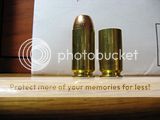Lee makes a cheap bulge buster die that is carbide so no lube required and the cases are pushed all the way through into sort of a hopper. This was mostly (but not exclusively) a glock thing...basically the mouth of the chamber, especially at the feed ramp were somewhat oversized to improve reliability...most semi-autos do this at least to some degree. If you take out your barrel and place a round in the chamber, you will notice a small gap around the rear of the cartridge (in some guns this gap is minimal, in other it's more significant). The gap will be biggest around the feed ramp...Semiautos that have minimal gap all the way around (especially at the feed ramp) are often said to have "fully" or "Well" supported chambers...in general, these are easier on brass and typically considered better suited to full power or +p loads (all else being equal). Keep in mind that a little bit of margin is required for reliable feeding.
In your Glock, as pressure goes up, the brass will likely develop the appearance of a "smile" (as seen in the pic in the posted link) which is where there is sort of a crease in the brass from where it has expanded into the portion of the chamber where the oversized feed ramp transitions to the nominally sized chamber.
In general, bulged brass can be resized (debulged if needed) and re-used. If there is a "smile" there is a good chance the load was somewhere between warm and possibly too hot. I would not reload brass with a noteable "smile", but would not hesitate to resize brass with a bulge.
This was most notably an issue in the older glock 40s. As mentioned above, glock has reduced this effect by tweaking their chamber dimensions...Most aftermarket Glock barrels are not so loose in the chamber/feed ramp as the factory barrels, this can effect feeding reliability if the chamber is "too tight"...
Remember...it's your melon behind the action when you crack off one of your loads...anything less than 100% confidence is too great a risk. Even though an occasional split case is not likely to be dangerous, it is likely tied to one or more of the following: "brittle" brass due excess work-hardening of the brass from significant resizing, large chambers, higher pressure loads.
For me...Keep an eye on all parameters including brass, keep plinker loads at modest levels (the paper won't know the difference) then Load, shoot, reload & repeat :-)
hope this helps






 Reply With Quote
Reply With Quote





